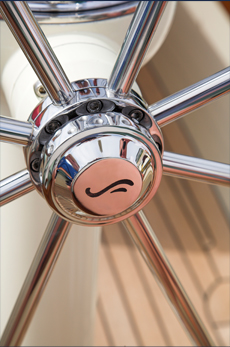About Us

Prismatic Coefficient
The prismatic coefficient (P.C.) is a technical term used to define how displacement is distributed along a hull, or how fine or full the ends of the hull are. Typical sailboats have a range of .45-.60 with a maximum theoretical number of 1.00 possible only for a submerged cylinder (e.g., a barge) with equal distribution of volume along the entire length.
The distribution of displacement, or P.C., has a great effect on the wave-making component of resistance of a hull through the water. Every boat (sail or power) has an optimum P.C. for a given hull speed. For example, a powerboat designed for high speeds has a light displacement hull with relatively fuller ends and a P.C. in the .70 range. However, when this boat is operated at lower speeds (below planing), a large wave develops and the boat operates far less efficiently because of the increased drag. In much the same way, a light displacement sailboat with a relatively higher P.C. can plane or surf downwind much more easily in a stiff breeze, but at lower boat speeds in light to moderate wind, the lighter boat will develop more wave-making resistance.
This phenomenon is greatly accentuated when one adds weight to a sailboat originally designed to be light. For example, many former stripped-out racing boats have been modified for cruising, only to discover that light air performance is considerably diminished. A sailboat originally designed with greater displacement and lower prismatic will be much less sensitive to added weight, because the P.C. stays more constant as the hull is immersed and the increase in displacement as a percent of total is less. This is an important consideration to the cruising sailor who needs to load onboard thousands of pounds in extra gear and provisions for any kind of extended voyage. Our designs typically have a P.C. in the range of .54-.55 to optimize performance in 8-15 knots of wind where Boat Speed /÷ rarely exceeds 1.2.
